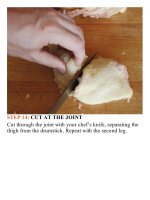The food lab better home cooking through science ( PDFDrive ) 100
Bạn đang xem bản rút gọn của tài liệu. Xem và tải ngay bản đầy đủ của tài liệu tại đây (133.79 KB, 2 trang )
and excessive moisture loss. In the United States, USDAstampedeggsareallwashedpriortopackaging,astepthat
removesthecuticle.Itmaymeanthatourpackagedeggsare
cleaner to begin with, but it does mean that they have less
protectionagainstfuturebacterialinfectionastheysitinthe
supermarket—refrigerationisnecessarytohelppreventthis.
But many eggs sold at farmers’ markets or in European
supermarkets have not been washed prior to packing.The
cuticle remains intact, so refrigeration is unnecessary, but
the eggs tend to have a shorter shelf life than refrigerated
eggs.
Q:Whataboutthe“pasteurizedeggs”I’mseeingonthe
marketthesedays?
Pasteurized eggs are a relatively new product. They are
sterilizedbysubmergingtheeggsinawaterbathataround
130°F,atemperaturethat,givenenoughtime,ishotenough
to kill any harmful bacteria on or inside the egg but cool
enoughthattheeggwon’tcook.Pasteurizedeggsareuseful
for people who like to eat their eggs runny or in raw
preparationslikemayonnaisebutdon’twanttorunthe(very
minimal) risk of getting sick from them. For most cooking
purposes, pasteurized eggs will work fine, though you’ll
notice that the whites are runnier (making them difficult to
poachorfry),andthattheytakeabouttwiceaslongtowhip
intopeaks.Theyolksworkjustaswellasthosefromregular
eggsinmayonnaiseorCaesarsaladdressing.
Q:Isittruethatbrowneggsarehealthierthanwhite?
Absolutelynot.Thecoloroftheeggshellhastodowiththe
breed of chicken, and it is largely controlled by market
demands. In most of New England, brown eggs are the
norm, while the majority of the rest of the country prefers
whiteeggs.Theyarecompletelyinterchangeable.
EggLabeling
Q:Imisstheolddays,whenIcouldwalkintothe
supermarketandpickupacartonofeggswithoutfeeling
likeIwasmakinganimportantlifedecision.Thesedays,
therearedozensofvarietiestochoosefrom.Whatdoall
thelabelsmean?
It is confusing, and it largely has to do with growing
consumer awareness about the conditions in which egglaying chickens are kept. Most spend their lives as little
more than egg-producing machines, housed in batteries of
individual cages, unable to spread their wings or even
move, with little or no access to a space where a chicken
couldperformitsnaturalbehaviors.Thelabelonthecarton
canbeanindicationofbetterwelfareforthebirds.
• Natural indicates that the eggs are minimally processed,
but since all eggs are sold minimally processed, the label
effectivelymeansnothing.Similarly,thetermFarm-Fresh
carrieswithitnoguarantees,becausepresumablynobody
issellingrotteneggsthatdon’tcomefromafarm.
• Free-Range,Free-Roaming, andCage-Free eggs come
from chickens that are not kept in battery cages, but
insteadinlargeopenbarnsorwarehouses.Thatisamajor
improvement in quality of life for the chickens, allowing
them to engage in natural behaviors like pecking, dust-









